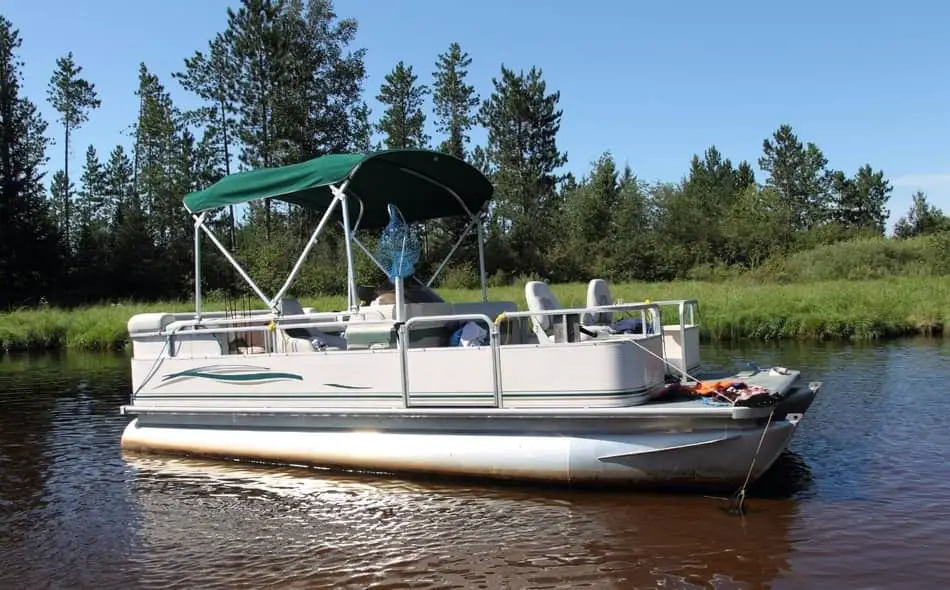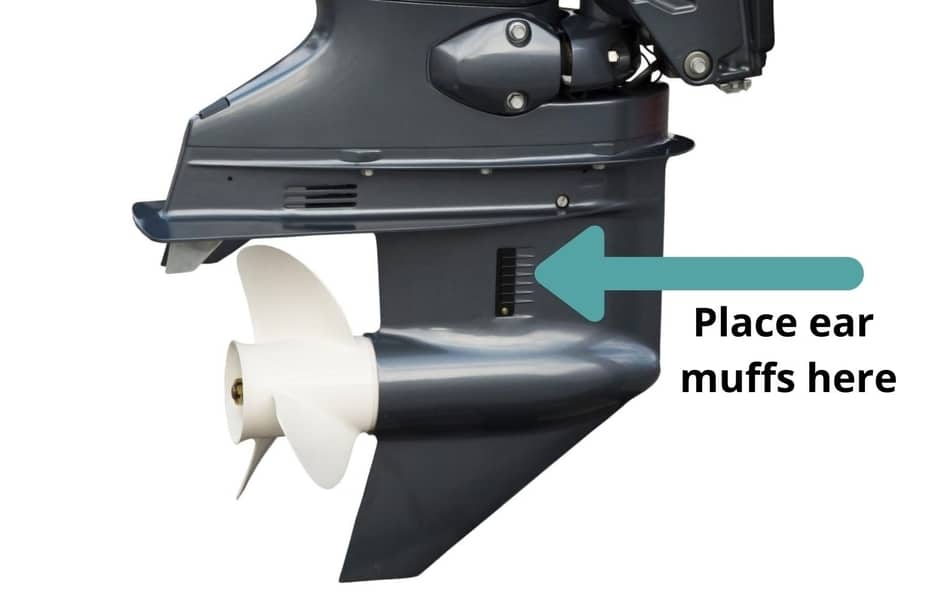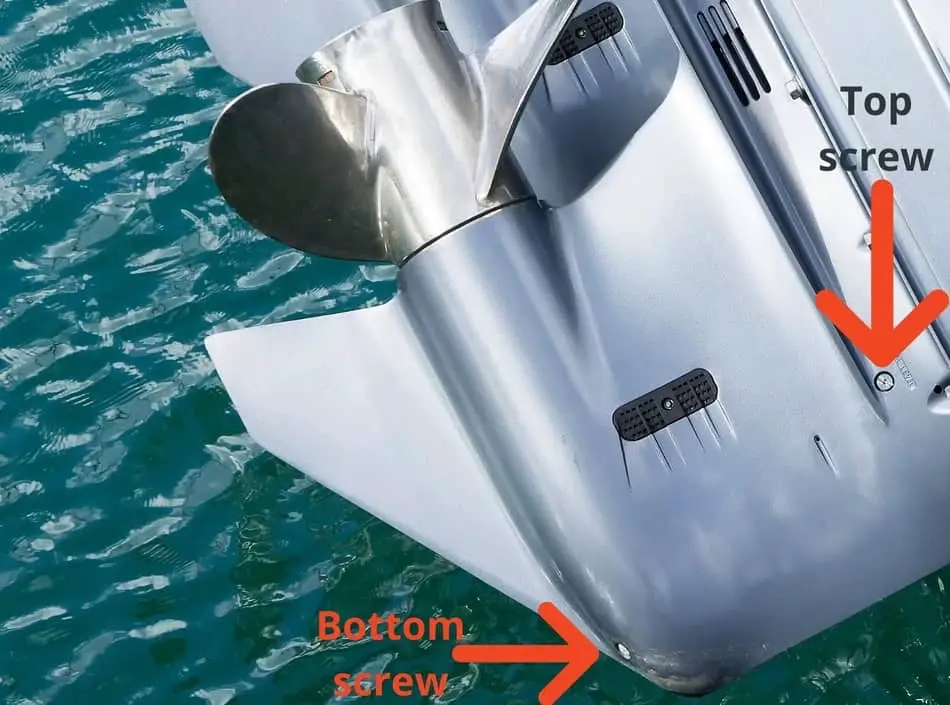Boating season is fun, and at the end of the season, you need to prepare the boat for the next season, which is winterization. Winterizing a boat is an essential job to do to run the boat efficiently or smoothly for the next boating season.
For the ones who don’t know how to winterizes a boat or the newbies may feel these steps are a little tricky while doing it for the first time. So follow the steps properly to winterize a pontoon boat quickly and fastly.
Related post – How to winterize a boat trailer: With 9 helpful tips (opens in a new tab). If you have a trailer, then winterizing the trailer is also a must.

1. Clean the boat entirely
Cleaning the boat hull is an essential step to do while winterizing the boat because if there is any growth on the boat hull, it can cause any problems to the hull over time (during the winter). While cleaning the boat, clean the bilge area as well.
First, start with the outer portions and wash the outer portion of the boat and the pontoon tubes completely with fresh water if there are any barnacles stains on the tubes, then use hull cleaners such as Starbrite hull cleaner (linked to Amazon), which removes them easily; no need to scrub them also.
Then after washing the hull, wash the inner portion of the boat as well. Use any cleaner to get rid of any stains or so. Then let it sit and dry for some time.
Some cleaning tips for a boat hull
- Use a microfiber cloth for cleaning the boat. It is a very soft cloth, and you can clean the things well with this cloth. And it will not leave any lint or dust on the surface of the boat.
- Use any cleaning liquid. Don’t clean the boat only with the water; use any boat hull cleaners or so. If you have any tough stains on the boat, it will remove the stains easily.
- Use a soft brush for general cleaning and a stiff bristle brush for tough stains. Don’t scrub too hard with a stiff bristle brush; it can peel off the bottom paint (if any).
- A 50/50 mix of vinegar with water is a good mixture to remove any water spots in the boat.
- Use the pressure washer (if you have any) and put some cleaner in the soap/cleaner injector place and spray it on the boat. Then wait for some time and then clean with normal water.
A pressure washer will help a lot with cleaning and washing the boat trailer and boat as well. Check the product in Amazon, click here, or click the image below.

After cleaning the boat properly, drain the boat completely. And then, start the winterization process.
Check my article on 11 Simple maintenance tips for a boat: DIY (opens in a new tab). In that article, I mentioned all the DIY maintenance tips you can do quickly to maintain the boat properly.
2. Stabilize the gas
Stabilizing the gas is an essential step to do if you have any fuel left in the tank, because nowadays, all the boats are using ethanol gas (E10 gas), which will create water inside the tank, and that water will damage the fuel tank over time. So, it is good to fill the tank more than 3/4th or full and add a stabilizer to it.
Topping up the fuel tank will prevent condensation inside the tank. And don’t leave the tank empty; it can cause problems (50/50 chances). A stabilizer is essential for an outboard motor while winterizing. Check the product in Amazon, click here, or click the image below.

Stabilizing the gas tank in a boat
- There are so many brands out there. Choose the perfect one for stabilizing. Now pour the stabilizer liquid into the gas tank, don’t pour the stabilizer how much you want. For every stabilizer you buy, they will give some instructions to use.
- Based on the instructions on the bottle, use it accordingly. If you use more, then the whole fuel (gas) will gum up. If you use less, it won’t stabilize the gas much. So, use it accordingly. They will tell to use 1oz for 10 liters or something like that, generally (quantity changes from brand to brand).
- After pouring the stabilizer into the tank, switch on the motor and leave it for some time (like 5 – 10 min). The stabilizer will flow inside all the fuel lines, carburetors, and cylinders, stabilizing the gas.
It’s good to use the stabilizer if you are not using your boat for 2 or 3 weeks. So, you won’t get any problems in the future. If you are storing the gas for a long time, then don’t forget to use a stabilizer.
Check this video on water formation in the gas tank, he explained it well
3. Flush the outboard motor with fresh water and then antifreeze
The outboard motor will intake water while boating to cool the motor. And that intake water may contain any dirt or salt particles if you are boating in saltwater, which will be stuck inside the motor and can damage the motor over time.
So, to clean that, we need to flush the motor with fresh water regularly. Since the winter storage is long term storage, it is good to flush the outboard motor before storing it.
And you should flush the motor after every ride so that the outboard motor will last long. Suppose, if you drive the boat in salt water and if you didn’t flush the outboard motor, then it will corrode quickly.
Related post – Effects of saltwater on a boat: With precautions, you need to take while boating in saltwater (opens in a new tab).
Flushing the outboard motor

- Generally, there will be holes at the bottom of the outboard motor (for water intake), just above the propeller (for some motors, there will be flush ports). Place air muffs over there and connect it to the water pipe and start pumping the water.
- The water will go inside the motor, and it will clean the inner walls with fresh water. After starting the process, leave it for 10 min. So, it will clean the inner walls properly. Start the outboard motor before pumping the water inside; otherwise, it will flood out the motor, which creates problems.
- It is essential to flush the outboard motor, with freshwater, after every use. If you are using the boat in saltwater, then flush the outboard motor after every use. If you are using your boat in fresh water, then flush the outboard motor after using your boat for two or three times.
- And at the end, first, stop pumping the water and then stop the motor; otherwise, it will flood out the motor.
- Finally, pour antifreeze into a bucket and then start pumping the water into the motor for the last time. Then cut off the water first and increase the motor rpm for 5 sec to pump out the extra water and stop the motor.
Check the Starbrite anti-freeze product in Amazon, click here, or click the image below.

You can do this while you are starting the outboard motor after pouring the stabilizer in the tank. You can stabilize the tank and flush the outboard motor at a time, for around 10 min. By doing that, you will save time.
4. Use fogging oil (in carburetor and cylinder)
After flushing the outboard with water, all the motor’s inner walls will contain droplets of water, which will damage the motor’s inner walls if you didn’t get rid of them. By using a fogging oil (it is a lubricant), it will coat all the inner walls of the motor with lubricant to prevent corrosion oner time.
So, a fogging oil will prevent corrosion by coating all the motor’s inner walls with lubricant. Fogging oil is essential for an outboard motor while winterizing. Check the product in Amazon, click here, or click the image.

Using fogging oil in an outboard motor
- You can do this process while starting the outboard motor to stabilize the tank and flushing water in the outboard motor with anti-freeze. The first three steps (stabilizing the gas, flushing the outboard motor with anti-freeze, and using fogging oil) can be done at a time.
- First, start with the carburetor, open the carburetor cap, and spray the fogging oil into all the carburetor holes while the motor is running (for 5 – 10 seconds). Repeat the whole process at least two or three times properly until the engine stalls.
- While doing this process, white color smoke will come out from the outboard motor. If the outboard motor engine stops while doing this process, it is a good sign. Which means the whole area inside the outboard motor is coated properly.
- After completing the carburetor part, close the carburetor cap, then stop the engine and open the spark plugs, and start spraying the fogging oil into these holes too. So, the inner layers of the cylinder will be coated as well.
- While doing the spark plugs part, don’t start the engine completely, just simply press the start button and stop immediately. While doing this process, close the spark plug holes with fingers or something, for coating the inner walls of the cylinder properly.
At that time, check the color of the center electrode of the spark plugs. If the center electrode of the spark plugs is black, then change them. Generally, the white color center electrode indicates that the spark plug is in good condition.
After finishing with the engine part, spray silicon spray (wd-40) (linked to Amazon) all over the wirings in the engine bay and inside the engine bay completely to prevent any corrosion over time. Spraying the wd-40 is an essential step to do while winterizing the boat to prevent any corrosion over time.
5. Change lower unit gear oil
Gear oil is used to rotate the propeller smoothly, which is located at the lower part of the outboard motor. Sometimes water can get into that gear oil, and if the gear oil is mixed with water and if you didn’t change it while winterizing, then water can freeze during the winter and can damage the whole lower unit.
Replacing the whole lower unit is expensive. To prevent that, it is recommended to replace the gear oil before winterizing the boat.
Changing the lower unit gear oil for an outboard motor

- There will be two screws fixed vertically in the lower unit of an outboard motor (it will vary from motor to motor; for some other motors, there will be only one screw to change the gear oil). Remove those screws to change the gear oil.
- First, open the lower screw, and then open the upper screw. If you open the top screw, then only all the gear oil will come out. The upper screw will hold the gear oil. If you open the upper screw first, the oil spills out. So, open the lower screw first.
- If the gear oil coming out from those holes is thick and dark, then there is no water present in the gear oil. If there is any change in the oil color and it is milky, then the oil is mixed with water.
- When the whole oil comes out, then pump the new oil from the lower hole until you see the oil coming out from the upper hole. Then, close the upper hole with the screw, and then close the lower hole with the screw.
Don’t hesitate to change the gear oil while winterizing your boat. Some people will not change the gear oil if there is no water content in the oil. Change the gear oil for every season to get good performance and to avoid any damage.
After that, spray wd 40 or any other spray on the wirings of the outboard motor. Just spray that on the wiring and wherever you want. Spray it all over the outboard motor to prevent any corrosion in the wirings over time.
6. Remove the batteries off the boat
Just turning off the boat will not prevent the battery from draining. You might not be aware of it, but when your boat is turned off, your battery could still draw power from things such as the radio, bilge pump, even a clock, etc. So, remove the battery from the boat during winterization.
When your boat is stored, these items will slowly drain your battery over time, especially if the battery is wired directly to any of these objects. You should disconnect the battery if you are winterizing your boat.
Removing the battery from the boat
- First, remove the battery (negative terminal first and then positive terminal). Then clean the battery with any cleaner and get rid of any dust stuck on the battery.
- After that, check the case properly, and make sure it doesn’t have any bulge or any other cracks on the battery. If there are any bulges or cracks on the battery means, you are overcharging the battery.
- Next, check the terminal posts. If the terminals are corroded, then clean it up with a terminal post cleaner or any small stiff bristle brush. Next, check the battery posts, clean them if corroded, use any cleaner or soda, and clean them.
- Every month check them and tighten them up. So, by doing that, you can prevent low voltage in the battery. If they are loose, then you will get low voltage.
- Then check the distilled water level, and you need to fill it if the level is less. Use only distilled water, not any other water or tap water. If you are using a lead-acid battery, then it is easy to refill the distilled water than a maintenance-free battery.
- Then check the voltage of the batteries and charge it if the voltage is low.
- Finally, coat the terminal posts with grease. These are the basic steps to do every once in a season to avoid any problems with batteries. Then store on any rubber surface in the garage or in your home to prevent any battery drain conditions.
Different voltage levels of all types of marine batteries are listed below in the table (source).
| Charge level | Sealed or Lead Acid battery (in volts) | Gel battery (in volts) | AGM battery (in volts) |
| 100% | 12.70+ | 12.85+ | 12.80+ |
| 75% | 12.40 | 12.65 | 12.60 |
| 50% | 12.20 | 12.35 | 12.30 |
| 25% | 12.00 | 12.00 | 12.00 |
| 0% | 11.80 | 11.80 | 11.80 |
7. Cover up the boat and use anti-pest
If you are storing the boat outside or in the water, then it is good to cover the boat.
Keeping the boat outdoors without any cover may damage the boat due to the weather during winter. If the water goes inside the boat, then it won’t come out. Anything (any living creatures) could go into the boat if you didn’t cover it. So, cover the boat with any boat cover during winter.
Covering the boat
- If you are keeping the boat indoors, then no need to worry about covering it much. But, if you are keeping the boat outdoors, then you should cover the boat with boat cover. Covering your boat will protect from elements like dirt, dust, moisture, and any living creatures.
- Then remove the propeller and cover that area with some cover. Else you can keep the propeller to the boat itself if you are okay with it. Then cover the whole outboard motor with the cover. So, nothing can go inside the motor.
- Try to remove any organic materials like canvas, leather, or other fabrics to avoid mold and mildew. And any electronics that could freeze should be removed to avoid damage.
- Make sure that there are no open holes in the boat. Any small creatures can get into the boat from the holes. Then, finally, cover the boat with a strong cover. So, it can withstand any harsh weather.
Check this trailer valet website on covering the boat, where they explained all the steps to do that click here (opens in a new tab).
8. Do regular checks during winter
Regular checks are essential for a boat if you are keeping the boat outdoors. Check the boat every one or two weeks to ensure everything is doing well or not. Generally, in the winter, snow might fall on the boat, clean it regularly.
Check my article on How long can you leave a boat in the water (opens in a new tab) to know all the basic things you need to do to prevent any growth on the boat hull.
Bottom line
By winterizing the boat properly, you can ensure that the boat will be in perfect condition for the next season. By doing it yourself carefully and efficiently, you can save $300 – $400.
